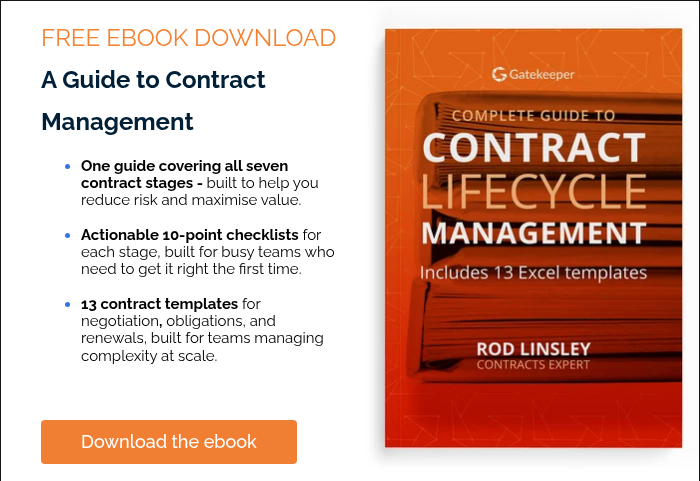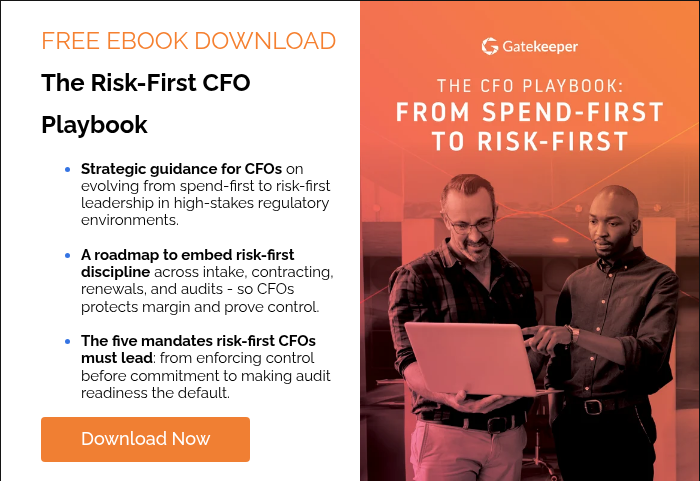Contract Renewal Management Challenges
Many organisations still approach contract renewals as isolated tasks, relying on spreadsheets, email reminders, or a patchwork of point solutions.
While these tools may make individual team tasks more efficient, they do not connect the dots between risk, spend, and contract data. The result is a fragmented renewal process that leaves businesses exposed.
- Lack of contract visibility: When contracts live in multiple systems or shared drives, renewal terms and obligations become invisible. A missed renewal on a vendor tied to production compliance, for example, could jeopardise certifications and stall critical operations.
- Silent auto-renewals: Contracts that roll over automatically can lock organisations into outdated terms, uncompetitive pricing, or vendor relationships that no longer meet compliance standards. In finance, failing to review a contract tied to data handling could trigger GDPR breaches or invite regulatory fines.
- Siloed communication: Legal, procurement, finance, and compliance teams often operate in isolation. Point solutions that serve one function deepen these silos, creating blind spots where renewal risks slip through unnoticed.
- Misplaced priorities: Not all contracts carry equal weight, but without a unified process, high-value or high-risk agreements are buried among lower-priority renewals. This dilutes focus and increases exposure in the areas that matter most.
- Last-minute decision-making: Renewals that are triggered too close to expiry leave no time for meaningful review or negotiation. The result is rushed decisions and missed opportunities, for example, a utility provider locked into an unfavourable supply contract that undermines its sustainability targets.
the Cost of poor contract renewal management
When contract renewals are handled in silos or left to manual tracking, the risks are become business-critical.
Poor renewal practices translate directly into compliance failures, financial leakage, and reputational harm, as well as:
- Regulatory non-compliance: Missed or outdated renewals can leave the business exposed to fines and audit failures. For example, a lapsed data-processing agreement could breach GDPR and trigger penalties running into millions.
- Margin erosion: Silent auto-renewals and outdated pricing structures drain budgets, while missed renegotiation opportunities prevent cost recovery and consolidation savings.
- Operational disruption: In industries such as healthcare or finance, service interruptions caused by missed renewals jeopardise critical operations and client trust.
- Reputational damage: Renewal mismanagement signals weak governance. It undermines stakeholder confidence and can strain vendor relationships at the very moment organisations should be strengthening them.
- Lost opportunities: Every renewal is a chance to improve terms, consolidate vendors, or secure better value. Without a unified view, these opportunities are missed, leaving savings and efficiencies untapped.
How to build a Best Practice Contract Renewal Strategy
A successful contract renewal strategy goes beyond checking dates or extending terms. It requires a risk-first, compliance-led approach that ensures every renewal protects the business, creates value, and aligns with wider organisational goals.
1. Define clear objectives
Every renewal should serve a purpose beyond continuation. Objectives might include reducing costs, consolidating vendors, improving service quality, or strengthening compliance.
Without clear goals, renewals risk becoming administrative exercises that preserve the status quo. By setting measurable objectives at the outset, organisations can transform renewals into value-creating checkpoints that contribute to board-level priorities such as cost efficiency, regulatory resilience, or sustainability.
2. Review contracts through a compliance lens
Renewals are natural points to test whether existing agreements are still fit for purpose. This means reviewing performance, obligations, and evolving risk requirements.
A vendor that met expectations two years ago may now be out of step with GDPR, DORA, or industry-specific standards. Treating renewals as compliance checkpoints ensures gaps are closed before regulators, auditors, or customers expose them.
A unified platform makes this review systematic rather than ad hoc, surfacing risks tied directly to each contract record.
3. Engage cross-functional stakeholders
Renewals cut across legal, procurement, finance, compliance, and IT, yet these teams often operate in silos. The result is that critical information is missed, from upcoming regulatory changes to shifts in vendor performance.
By aligning all stakeholders early in the renewal process, organisations can avoid conflicting priorities and make informed decisions.
4. Prioritise high-value and high-risk agreements
Not all renewals deserve equal attention. Agreements tied to regulatory compliance, core service delivery, or significant financial commitments carry more weight than low-value or low-risk contracts. Without prioritisation, resources are spread thin and strategic risks are overlooked.
A structured renewal strategy should focus proactive review on high-value contracts, while applying standardised workflows for routine agreements. This ensures that effort is directed where the business impact is greatest.
5. Establish a proactive renewal timeline
Many organisations start the renewal process too close to contract expiry, leading to rushed reviews and weak negotiating positions.
Building a proactive timeline, with checkpoints months in advance, creates space for stakeholder consultation, compliance checks, and market benchmarking.
This prevents organisations from being forced into unfavourable auto-renewals or hurried extensions.
6. Negotiate from a position of strength
Renewals are one of the most effective moments to rebalance commercial terms, but only if the business comes prepared.
Data on vendor performance, market alternatives, and historic spend provides leverage to secure better pricing, stronger service-level commitments, or alignment with evolving goals.
Approaching negotiations armed with evidence turns renewals into opportunities to recover margin, eliminate inefficiencies, and deepen partnerships with the right vendors.
7. Use a unified platform, not siloed tools
Manual trackers and point solutions only make siloed tasks more efficient, they do not connect the dots between risk, contracts, and spend.
This leaves organisations exposed to the very problems renewals are meant to prevent, such as compliance breaches, margin leakage, and surprise auto-renewals.
A unified platform like Gatekeeper, powered by LuminIQ, makes renewals dates visible before they become risks. It flags potential issues early and links obligations directly to compliance evidence. It also surfaces spend data in context with the contract. Together, these capabilities transform renewals from administrative exercises into strategic levers.
8. Monitor and improve continuously
A contract renewal strategy should not be static. Regulatory frameworks, market conditions, and vendor performance shift constantly.
The most effective strategies build in continuous monitoring so that risks, obligations, and opportunities are reassessed in real time.
Each renewal then feeds new insights back into the lifecycle, closing the loop.
How Gatekeeper Helps with Contract Renewals
Gatekeeper, powered by LuminIQ Agents, ensures contract renewals are never just routine deadlines. By unifying risk, contract, and spend data, every renewal becomes a moment to secure compliance, recover margin, and strengthen vendor relationships.
- Never miss a renewal: Gatekeeper preserves institutional knowledge with workflow-driven approvals and automated alerts. LuminIQ agents surface renewal dates early, so no contract silently rolls over on unfavourable terms.
- Negotiate every renewal with confidence: LuminIQ automatically pulls spend history, performance metrics, and contract terms into one view at the point of renewal. This evidence arms teams to renegotiate stronger terms, consolidate vendors, and prevent wasted spend.
- Renew with compliance built in: Every renewal ismade by teams who are risk-aware. Gatekeeper and LuminIQ flag vendor financial, cyber, or sanctions risks before contracts are signed again, ensuring renewals don’t reopen the organisation to regulatory exposure.
- Turn renewals into savings opportunities: Rather than rubber-stamping the status quo, Gatekeeper highlights where renewals can drive consolidation or eliminate redundant services. Customers have saved over $1.3M by removing unnecessary renewals and optimising vendor portfolios.
With Gatekeeper, contract renewals stop being administrative checkboxes. They become checkpoints where compliance is reinforced, risks are closed, and measurable value is unlocked.
Wrap up
Contract renewals should never be treated as routine deadlines. Managed well, they are strategic checkpoints - opportunities to reinforce compliance, recover margin, and strengthen vendor relationships. Managed poorly, they become silent risks that erode trust and profitability.
Gatekeeper transforms renewals by unifying risk, contract, and spend data into a single platform, powered by LuminIQ AI agents. The result is simple: no missed renewals, no compliance surprises, and no wasted spend. Instead, every renewal becomes a moment of clarity and control.
Ready to see how Gatekeeper can turn renewals from hidden risks into measurable value? Book a demo today and experience how our unified platform helps you stay ahead of every renewal with confidence.





.png)
.png)
.png)
-4.png)